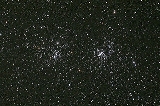
NGC 884
Encyclopedia
NGC 884 is an open cluster
located 7600 light years away in the constellation of Perseus. The cluster is most likely around 12.5 million years old. It is the easternmost of the Double Cluster
with NGC 869
. Located in the Perseus OB1 association both clusters are located physically close to one another, only a few hundred light years apart. The clusters were first recorded by Hipparchus
, but have likely been known since antiquity.
The Double Cluster is a favorite of amateur astronomers. These bright clusters are often photographed or observed with small telescopes. Easy to find, the clusters are visible with the unaided eye between the constellations of Perseus and Cassiopeia as a brighter patch in the winter Milky Way
.
In small telescopes the cluster appears as a beautiful assemblage of bright stars located in a rich star field. Dominated by bright blue stars the cluster also hosts a few orange stars that add to the visual interest. Both clusters together offer a spectacular low magnification view.
Sometimes known as χ Per this designation more probably refers to both clusters.
Open cluster
An open cluster is a group of up to a few thousand stars that were formed from the same giant molecular cloud and have roughly the same age. More than 1,100 open clusters have been discovered within the Milky Way Galaxy, and many more are thought to exist...
located 7600 light years away in the constellation of Perseus. The cluster is most likely around 12.5 million years old. It is the easternmost of the Double Cluster
Double Cluster
The Double Cluster is the common name for the naked-eye open clusters NGC 884 and NGC 869 , which are close together in the constellation Perseus. NGC 884 and NGC 869 are at distances of 7600 and 6800 light-years away, respectively, so they are also close to one another in space...
with NGC 869
NGC 869
NGC 869 is an open cluster located 7600 light years away in the constellation of Perseus. The cluster is most likely around 13 million years old. It is the westernmost of the Double Cluster with NGC 884. Located in the Perseus OB1 association both clusters are located physically close to one...
. Located in the Perseus OB1 association both clusters are located physically close to one another, only a few hundred light years apart. The clusters were first recorded by Hipparchus
Hipparchus
Hipparchus, the common Latinization of the Greek Hipparkhos, can mean:* Hipparchus, the ancient Greek astronomer** Hipparchic cycle, an astronomical cycle he created** Hipparchus , a lunar crater named in his honour...
, but have likely been known since antiquity.
The Double Cluster is a favorite of amateur astronomers. These bright clusters are often photographed or observed with small telescopes. Easy to find, the clusters are visible with the unaided eye between the constellations of Perseus and Cassiopeia as a brighter patch in the winter Milky Way
Milky Way
The Milky Way is the galaxy that contains the Solar System. This name derives from its appearance as a dim un-resolved "milky" glowing band arching across the night sky...
.
In small telescopes the cluster appears as a beautiful assemblage of bright stars located in a rich star field. Dominated by bright blue stars the cluster also hosts a few orange stars that add to the visual interest. Both clusters together offer a spectacular low magnification view.
Sometimes known as χ Per this designation more probably refers to both clusters.

